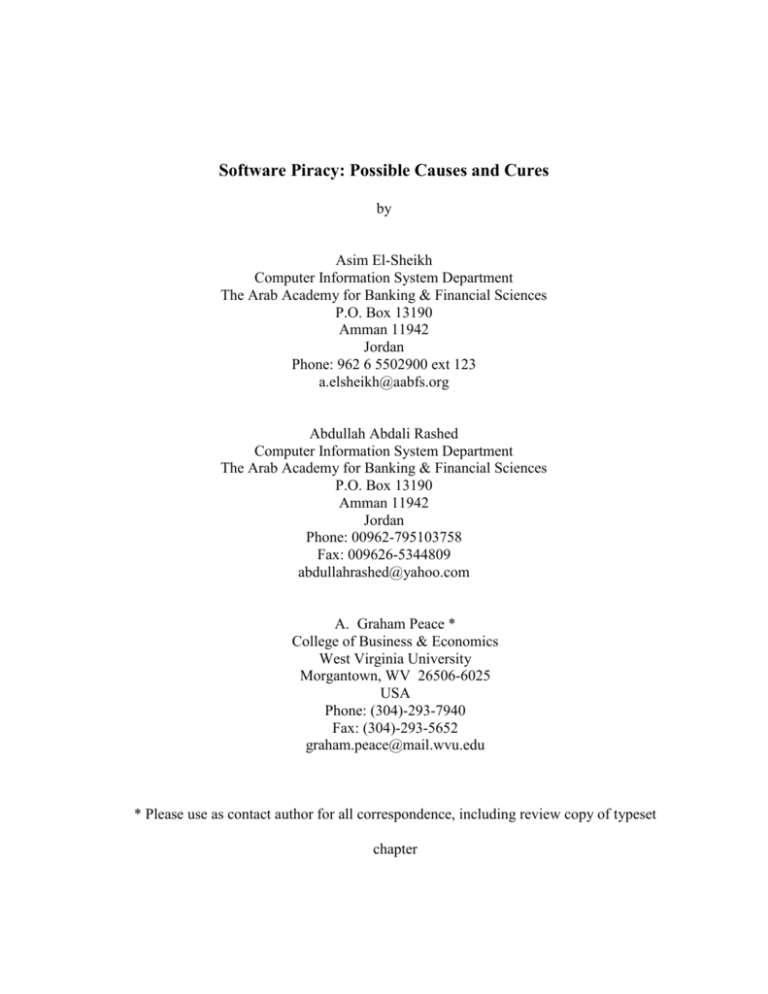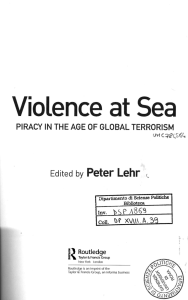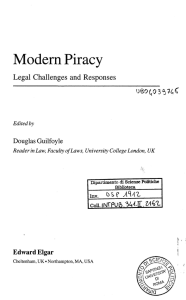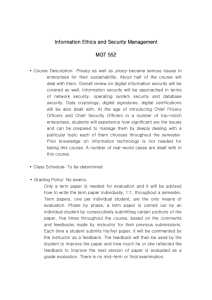Software Piracy: Possible Causes and Cures
advertisement

Software Piracy: Possible Causes and Cures by Asim El-Sheikh Computer Information System Department The Arab Academy for Banking & Financial Sciences P.O. Box 13190 Amman 11942 Jordan Phone: 962 6 5502900 ext 123 a.elsheikh@aabfs.org Abdullah Abdali Rashed Computer Information System Department The Arab Academy for Banking & Financial Sciences P.O. Box 13190 Amman 11942 Jordan Phone: 00962-795103758 Fax: 009626-5344809 abdullahrashed@yahoo.com A. Graham Peace * College of Business & Economics West Virginia University Morgantown, WV 26506-6025 USA Phone: (304)-293-7940 Fax: (304)-293-5652 graham.peace@mail.wvu.edu * Please use as contact author for all correspondence, including review copy of typeset chapter Software Piracy: Possible Causes and Concerns ABSTRACT Software piracy costs the information technology industry billions of dollars in lost sales, each year. This chapter presents an overview of the software piracy issue, including a review of the ethical principles involved, and a summary of the latest research. In order to better illustrate some of the material presented, the results of a small research study in the country of Jordan are presented. The findings indicate that piracy amongst computer using professionals is high, and that cost is a significant factor in the decision to pirate. Finally, some potential preventative mechanisms are discussed, in the context of the material presented previously in the chapter. KEYWORDS Copyright Law, Computing in Developing Countries, Copyright Protection, Cultural Differences, Cultural Values, Information Ethics, Intellectual Property Rights, IS Ethics, IT in Developing Countries, Licensing, Piracy, Proprietary Rights, Software Copyrights, Software Copyright Infringement, Software Piracy, Software Protection INTRODUCTION Software piracy takes place when an individual knowingly or unknowingly copies a piece of software in violation of the copyright agreement associated with that software. Despite the best efforts of industry organizations, such as the Business Software Alliance (BSA) and the Software and Information Industry Association (SIIA), and extensive legislation in many countries, piracy is rampant in most parts of the world. While illegal copying has decreased in the past few years, most likely due to the activities mentioned above, it is estimated that piracy cost the software industry a combined US$13 billion, in 2002 alone. 39% of all business application software installed in 2002 was pirated (BSA, 2003). This paper will discuss the current state of the research into software piracy, focusing specifically on potential causes and cures. The results of a study of software piracy in the country of Jordan are presented, both to demonstrate the extent of the problem outside of the typically studied Western world, and as a basis for discussion of the theories and data presented in the rest of the paper. It is hoped that this chapter will make the reader aware of the major issues involved in preventing piracy. BACKGROUND The growth of the importance of software in both the personal and professional worlds has led to a corresponding increase in the illegal copying of software. While academic research often splits illegal software copying into “software piracy” (the act of copying software illegally for business purposes) and “softlifting” (the act of copying software illegally for personal use), this paper will use the term “software piracy” to encompass both activities, as is often done in the popular press. The following paragraphs provide an overview of the ethical issues involved in the decision to pirate, and the results of previous research. The Ethics of Piracy The ethics of piracy are not as cut and dry as it may first seem. By definition, when piracy is committed, the copyright agreement or software license is violated, clearly breaking the law. However, does that make the act unethical? Obviously, the fact that something is illegal does not necessarily make it unethical, and vice versa (many laws have been overturned when their unethical nature became apparent, such as laws governing slavery). Also, in the case of digital products, such as software, we are faced with the unique situation where the product can be replicated at virtually no cost, and without “using up” any of the original version. So, while piracy is technically stealing, it is quite different in nature than the stealing of a material item, where the original owner is then denied the usage of the item taken. In the case of illegal software copying, several ethical issues come into play. In one of the few studies utilizing ethical theory to study the piracy problem, Thong and Yap (1998) found that entry-level IS personnel use both utilitarian and deontological evaluations to arrive at an ethical decision regarding whether or not to pirate. The authors concluded that efforts to encourage ethical behavior in IS personnel should include training in ethical analysis and enforcement of an organizational code of ethics. From a utilitarian or consequentialist perspective, where the focus is on the results of the action more so than the action itself, arguments can be made that an individual act of piracy is not unethical. Assume that an individual can significantly improve his or her productivity in the workplace by installing a pirated copy of Microsoft Excel. While the employee completes the same amount of work in a single day, he or she is now able to leave work earlier and spend more time with his or her family, thus increasing their happiness. If the organization was not going to purchase the software under any circumstances, it is difficult to claim that Microsoft is financially damaged, as no sale would have taken place. In any case, one further sale of Excel would do little to impact Microsoft’s overall profits, and most likely would not outweigh the good created by the employee playing with his or her children, for an extra hour or so each day. In the end, the individual and his or her family benefit, while the creator of the software is not significantly harmed. The organization, and even society, may also benefit, as the individual and his family will be happier and the employee will be under less stress to complete things on time. From a utilitarian viewpoint, the benefits of this single case of piracy may outweigh the costs, implying that the act is ethical in nature. Some researchers have claimed that software piracy may even benefit software companies, as individuals who would never have been exposed to a software product are given the opportunity to try the software at no cost, which may lead to future purchases of the product, if it benefits the user (Givon, et. al., 1995). This is similar to the concept of providing trial versions of products. If this is the case, the utilitarian arguments defending piracy behavior are strengthened, although further study of this claim is required. However, what if everyone pirated software, instead of just one individual? The situation now changes dramatically. Software manufacturers would see a drastic reduction in income, and would eventually have to either go out of business, or greatly reduce their activities. The rapid pace of technological growth seen over past two decades have would slow down significantly. Open source products, such as Linux, have demonstrated that a non-profit software industry can still lead to technological advancement, but it is hard to imagine the advance continuing at the same pace, with no profit motive in place. Even programmers have to eat. Therefore, a single act of piracy in a situation where the software would never have been purchased seems the easiest to defend, from an ethical standpoint. However, if the piracy is replacing a potential legitimate purchase, the equation is changed. Any large scale commitment of piracy of this type would lead to serious damage to the software industry which, in turn, would negatively impact future software development. It could certainly be argued that the costs would outweigh the benefits. From a deontological perspective, things are somewhat clearer. Deontologists argue that the act itself is ethical or unethical, regardless of the outcomes. In the case of piracy, the facts are clear – the software corporation has expended its research and development money to create the software, usually for the purposes of recouping the development costs and creating an income stream. These corporations legally create software licensing agreements that purchasers voluntarily enter into, when they purchase the software. Those agreements, in most cases, prohibit the unauthorized copying of the software for purposes other than backing up the software. As the purchase is voluntary and certainly not a necessity for life, one has to argue that the purchaser is ethically bound to abide by the licensing agreement. The fact that so many individuals and organizations have voluntarily purchased software and abided by the licensing agreements, without major complaint, is further evidence that these licenses are generally accepted to be fair and ethical. Therefore, allowing for that software to be copied, in violation of the agreement, is unethical – it is the same as breaking any other contract where both sides, in full knowledge of the situation, voluntarily enter into an agreement to abide by a set of rules. Breaking those rules, especially unbeknownst to the other party, is clearly an unethical act, as it violates the other entity’s trust. It may not be stealing, in the material sense, but it is a violation of a voluntary contract, none-the-less. Looked at another way, using Immanuel Kant’s Categorical Imperative, we want people to act in a way that is universally applicable (i.e. the way in which we would want all people to act, in that situation). In the case of standard legal business agreements, we certainly cannot envision a situation where we would want all people to violate those agreements, especially in secret. Therefore, it must be unethical to break the software licensing agreement by copying the software illegally or using an illegally copied version of the software, against the software creator’s wishes. One interesting caveat to this discussion is the role of cultural norms. In the Western world, it is commonly accepted that the creator of intellectual property is granted rights to exploit that property for financial gain, if he or she so wishes. The foundations of copyright and trademark law are based on the view of ownership. Just as material items can be owned, so can intellectual property, and the right of ownership can be protected by legal and ethical means. Given that the technology industry developed primarily in the United States and Western Europe, it is not surprising that the legal concepts of intellectual property rights were developed in parallel. However, in many other cultural traditions, most notably in Asia, the concept of individual ownership of intellectual property is not as common. For example, while in the Western world artists are rewarded and recognized for creating unique works, and often criticized for “copying,” in many Eastern traditions, success can be gained through the replication of works and styles created by previous masters. In another major difference, the focus in many Eastern societies is on the collective, as opposed to the individual. In the United States, in particular, individualism is encouraged and rewarded. Uniqueness is seen as a strength, in many cases, whereas in Asian culture, it is much more important to assume the proper role in the group. Individualism is often seen as a negative, and people strive to become part of the whole; individualism is sacrificed for the benefit of the group. In a culture such as this, it is easy to see how the concept of individual ownership of a virtual property, especially one that can be copied and distributed at no cost to the originator, can be difficult to establish. Hence, it is not surprising to see that countries such as Vietnam (95%), China (92%), and Indonesia (89%) lead the world, in terms of piracy rates (BSA, 2003). The cultures of these countries have a different concept of intellectual property than the cultures of Western Europe and North America. This leads to the idea of cultural relativism, which states that ethics are based on a society’s culture. Therefore, individuals in cultures with different attitudes and norms can undertake completely opposite acts, although both could be acting ethically. While the concept of intellectual property in Western culture makes it easy to claim that piracy is unethical, it may be that cultural norms in societies like those found in Asia are such that the act of piracy is simply not seen as unethical. As the global marketplace becomes a reality, and Western business concepts are embraced across the international spectrum (witness China’s recent admission into the World Trade Organization), it seems inevitable that Western concepts of intellectual property will have to be accepted by other cultures and their corresponding legal systems. However, it may be a slow process, and will require well developed educational programs. Until the time that intellectual property rights are fully understood and accepted into non-Western cultures, the initial rush to judgement regarding the unethical nature of software copying in those societies must be tempered with an understanding of the cultural traditions in which those ethics were developed. Previous Research In recent years, a small research stream has developed in the academic literature regarding the causes and potential cures of piracy. Not surprisingly, initial studies focused on the extent of the problem. Shim and Taylor (1989) found that over 50% of managers admitted to copying software illegally, consistent with a later study of computer-using professionals by Peace (1997). Several other studies found piracy to be common among college students (e.g. Oz, 1990; Paradice, 1990). Males have been found to commit piracy more often than females, while age has been found to be negatively correlated with piracy (i.e. younger people copy software illegally more often than older people) (Sims, et. al., 1996). When combined with the yearly reports by the BSA and SIIA, it is evident that a significant percentage of computer users are pirating software, and that the software industry faces billions of dollars in lost sales, each year. In recent years, studies have focused more on the causes of piracy. In one of the initial attempts to build a model of piracy behavior, Christensen and Eining (1991) utilized the Theory of Reasoned Action (TRA). TRA posits that a person’s behavioral intention is the leading predictor of whether or not the person will carry out that behavior. In other words, if someone intends to do something, then he or she probably will. Intention, in turn, is predicted by the individual’s subjective norms (i.e. the perception of pressures from the external environment, such as peer norms) and the individual’s attitude towards the behavior (positive or negative, based upon the perceived consequences of the behavior). The authors found that attitude and peer norms are directly related to piracy behavior (although they did not utilize a construct for intention, in their study). TRA has been expanded to include the concept of perceived behavioral control; the individual’s perception of his or her ability to actually undertake the behavior in question (Ajzen, 1991). The resulting theory is known as the Theory of Planned Behavior (TPB), and it has been empirically tested in many situations, with successful results. In the most recent major study of piracy behavior, Peace, et. al. (2003), used TPB as a base for the development of a more complete model of piracy behavior (see Figure 1). Economic Utility Theory (EUT) and Deterrence Theory were utilized to identify the antecedents of the main TPB constructs, including the cost of the software, the severity of potential punishment (punishment severity), and the probability of being punished (punishment certainty). Each was found to be an important factor in the decision to pirate, and the model was found to account for 65% of the variance in piracy intention. Research into software piracy has come a long way from its humble beginnings in the late 1980s. The model developed by Peace, et. al., (Figure 1) is a major step forward from the first attempts to identify the factors that lead to the decision to pirate. We will return to the discussion of these factors, and what they tell us about piracy prevention, later in the chapter. The next section details a study of software piracy in the little analyzed country of Jordan. Punishment Severity - Attitude + + Software Cost - Subjective Norms + Piracy Intention + Punishment Certainty - Perceived Behavioral Control Figure 1. Model of Software Piracy Behavior (Peace, et. al., 2003) THE STUDY Almost all academic piracy research to date has focused on the industrialized nations of Europe, Asia and North America. To add interest to the discussion of software piracy’s causes and potential cures, the authors undertook a small study of piracy behavior in the country of Jordan. Jordan entered the World Trade Organization in 2000 and signed a free trade accord with the United States in the same year. An association agreement was signed with the European Union in 2001, leading to increases in trade and foreign investment. 83% of the workforce is employed in the services industry, and approximately 212,000 of the country’s population of 5.5 million have regular Internet access (CIA World Factbook, 2004). Background The BSA’s statistics indicate that software piracy is prevalent in the Middle East, although there have been signs of significant improvement, over the past several years. From a high of 84% in 1994, piracy rates have decreased to 50%, in 2002, representing a dollar loss to the software industry of US$141 million (BSA, 2003). This is a small number, when compared to the nearly US$5.5 billion in losses sustained in the Asian market, or the US$2.2 billion lost in North America, which perhaps accounts for the lack of detailed research into software piracy in Middle Eastern countries. Jordan has a small but growing information technology industry, currently employing approximately 10,000 people and generating US$167 million in annual revenue (Usaid.gov, 2004). The government has placed a clear emphasis on developing this sector, and also on reducing piracy. In 1999, Jordan’s parliament amended the country’s 1992 Copyright Law and passed various regulations to better protect intellectual property. Two years later, King Abdullah received a special award from the BSA for his efforts to enforce the country’s copyright and trademark laws. Largely due to these efforts, software piracy in Jordan has seen a steady decline since 1994, when rates reached 87%. By 2002, piracy rates had dropped to 64%, although the total losses to the software industry had risen, from US$2.2 million in 1994 to US$3.5 million in 2002 (BSA, 2003). Method For the purposes of this study, questionnaires were distributed to a sample of adults taking graduate level evening classes at the Arab Academy for Banking and Financial Services in Amman, Jordan. Engineers and programmers in the telecommunications industry in Amman were also surveyed. No incentives were given for completing the questionnaire, and all respondents were promised anonymity. Almost all of the respondents were employed. This sample was chosen as it provided an available group of business professionals with the ability, opportunity and knowledge to use computer technology. All of the respondents indicated some training with computers during their education, and 53% stated that they worked with computer technology on a daily basis. Results 102 questionnaires were distributed and 98 were returned. However, 12 surveys were deemed unusable, as those respondents indicated that they did not use computers, either at work or at home, leaving 86 surveys for a usable response rate of 84.3%. 86% of the respondents were male, which is not surprising, given the make-up of the workforce in both the software industry and the Middle East in general, each of which are male dominated. 24 (28%) respondents ranged in age from 20-25 years old, 37 (43%) respondents ranged in age from 25-30 years old, and the remaining 25 (29%) were older than 30 years of age, at the time of the survey. The sample was well educated, with 58% of the respondents holding a Bachelor’s degree, and a further 37% holding a Master’s degree or higher. The majority of the respondents (64%) were employees in industry, 20% were students only, and 15% were either university personnel or privately employed. 46 (53%) of the respondents had a computer at home, 18 (21%) used a computer at work, and 22 (26%) had computers available both at home and in the workplace. Almost half of the respondents had used computers for more than six years, while all respondents had used computers for at least one year. When asked about their knowledge of the laws regarding software copying, 86% reported understanding the concept of software piracy, while 13% reported no knowledge of the issue. Of those that reported an understanding of the subject, 24% reported learning about piracy at school, 41% from media reports, and 34% reported knowledge from both sources. Rather surprisingly, the respondents were very open about their software copying habits. A troubling 80% of the respondents admitted to using illegally copied software. When asked for the main reason behind their usage of pirated software, price was the number one issue raised. 61% of the respondents listed the cost of software as the main reason for committing piracy. A further 18% responded that they simply saw no reason for paying when the software was available for free. 78% stated that they were satisfied with their decision to pirate software, while the remaining 22% admitted to some dissatisfaction or guilt associated with their choice. The respondents were asked to list the source of their pirated software. 86% received software from friends or colleagues both within and outside of their organization. Surprisingly, 17% stated that their pirated software came with the PC that they had purchased, and 3.5% claimed to have received pirated software from a software industry professional, indicating that the problem is inherent in the supply chain. This may relate to the discussion of cultural relativism, described above. When their attitudes were studied further, 76% stated that it is “fair” to be asked to pay for software, since software companies had expended effort to produce the product. Also, 74% thought that it was necessary to require the purchasing of software, in order to sustain the software industry. However, only 3.5% of the respondents stated that they had personally purchased legal software from a technology company, in the past. Discussion The most obvious result of the survey confirms the findings of the BSA. Piracy is a serious problem in the Middle East and the act of piracy is not seen in a negative light. The piracy rate found in this survey is much higher than the 64% found by the BSA, most likely due to the sample utilized – computer-using professionals who have the knowledge, skills and opportunity to pirate. While the Middle East is not a major user of software, when compared to the industrialized nations of Europe and North America, the numbers are still significant and indicative of the work that must be done to combat illegal software copying. Perhaps most disturbing is the fact that 78% of the respondents seemed to show no remorse, despite the fact that 86% claimed to understand the concept of piracy, indicating that they knowingly committed an illegal act. It is also interesting to note that the majority of the software pirates believed that being asked to pay for software is fair, and even necessary to maintain the software industry, showing an obvious conflict between their views and actions. There is clearly a lot of work to be done, if piracy is to be fully understood and prevented in the future. POTENTIAL CURES The SIAA and BSA have undertaken a two-pronged approach to reducing the problem of piracy: enactment and enforcement of applicable laws (i.e. punishment as a deterrent), and education of organizations and individuals as to the ethical and legal implications of pirating. There is evidence from the academic literature that each of these efforts is useful. In particular, punishment is an important factor. Peace, et. al. (2003), found that the level of punishment is directly related to the individual’s attitude towards piracy; the higher the perceived level of punishment, the more negative the individual’s attitude, and the more unlikely the individual will be to intend to pirate. In fact, punishment levels are quite high. In the United States, for example, punishment can include jail time and fines of up to US$250,000. However, do people truly believe that they, personally, will incur these punishments? High punishment levels are not enough; the individual must perceive the levels to be high, and they must also perceive that pirates are likely to be caught. When looking at the case of Jordan, the fact that 80% of the individuals surveyed freely admitted to copying software illegally gives the impression that they do not perceive the risks of being punished to be high. In reality, while the efforts of the BSA and SIIA to bring pirates to justice have led to some highly publicized convictions, the fact is that most pirates are not caught and freely commit the crime with no negative consequences. The perceptions of punishment severity (the level of punishment) and punishment certainty (the chance of incurring punishment) relate to the education efforts of the industry trade groups. While the unethical nature of the act is important, making potential pirates aware of the possible punishments has been a main focus of the BSA. One look at their web page (http://www.bsa.org) quickly makes the individual aware of their tactic to publicize the potential punishments that pirates face and the fact that some individuals and organizations are actually being caught. There is a clear goal of increasing the individual’s perception of the levels of punishment certainty and severity. In the case of Jordan, over 73% of the respondents indicated that they had become informed of the issue of piracy at least partially through the media, which indicates that that the campaign of industry groups is working – the word is being spread. However, with over a quarter of respondents claiming no information from the media, and 13% claiming to have no knowledge of the issue at all (keeping in mind that many of these respondents work in the technology industry), there is still work to be done. On an organizational level, punishment severity and certainty can also be useful tools. Companies wishing to reduce piracy can use punishment effectively; auditing can be carried out to find pirated software, and those committing piracy can be punished. Similarly, research shows that peer norms are a factor in the decision to pirate (e.g. Peace, et. al., 2003). Establishing a corporate culture that promotes only the legal use of software, combined with punishment for those that do not comply, can greatly reduce piracy in an organization. As suggested in the literature, corporate codes of conduct can aid in this endeavor (e.g. Thong and Yap, 1998). Software cost is a more interesting aspect of the problem. As can be seen in the study results, cost is a significant factor in the decision to pirate. 61% of those admitting to piracy listed software cost as the major reason. It would not be surprising to find that cost is more of an issue in a country such as Jordan, with an annual per capita GDP of US$4,300, as opposed to the United States, where per capita GDP is a much greater US$33,600 (CIA World Factbook, 2004). Peace, et. al.’s (2003) model also found that price plays a significant role in the piracy decision. Some interesting suggestions have been made, in this area. Clearly, incomes differ in various parts of the world. Therefore, the importance of the cost of the software may vary on a regional level, based on things such as per capita GDP and income. Researchers, such as Gopal and Sanders (2000) and Moores and Dhillon (2000), have suggested that price discrimination strategies could be used as a tool to combat piracy. In countries with lower per capita incomes or GDPs, such as Jordan, reduced prices could be used to limit the incentive to pirate. This is an area very deserving of future study. Another area much deserving of future research is the impact of local culture on piracy. As stated above, cultural relativism in the area of ethics is a potential issue, as some cultures do not have a history of protecting intellectual property rights, and the concept of intellectual property ownership is mainly a Western ideal. Also, most major research to date has focused on the industrialized countries of Europe and North America. Gopal and Sanders (1998) have called for further study of the cross-cultural aspects of piracy, and a fruitful research stream awaits for those willing to focus on this area of the problem. CONCLUSION This chapter provides an overview of the topic of software piracy, including the results of a study of illegal software copying in the country of Jordan. Piracy costs the software industry billions of dollars each year, but through the two pronged approach of education and enforcement, industry groups such as the BSA and the SIIA have managed to greatly reduce piracy worldwide. However, the issue of software cost appears to be a major factor in the decision to pirate, indicating that price discrimination strategies may have to be used to truly impact illegal software copying in much of the world, and cultural relativism may make changing habits difficult, in some societies. Looking into the future, the case of software piracy provides insight into what is quickly becoming a larger intellectual property rights issue: the illegal downloading of both music and video files via the Internet. Not including Internet downloads, it is estimated that piracy of CDs and cassettes cost the entertainment industry US$4.6 billion in 2002 (IFPI, 2003). There are many similarities between software piracy and entertainment piracy, and the lessons learned in the software arena can provide insight into how to deal with this new issue. With the spread of technologies such as Kazaa and bittorrenting, the ability to copy any digital product quickly, easily, and almost anonymously threatens the value of the intellectual property that has created great wealth for Bill Gates and David Bowie alike. It is imperative that the ethical, legal and technological factors involved are studied further, so that prevention and protection strategies can be devised to protect the rights of those creating intellectual property. REFERENCES Ajzen, I. (1999). The Theory of Planned Behavior. Organizational Behavior and Human Decision Processes, 50, 179-211. BSA (2003). Eighth Annual BSA Global Software Piracy Study. Washington, DC: Business Software Alliance. Christensen, A., and Eining, M. (1991). Factors Influencing Software Piracy: Implications for Accountants. Journal of Information Systems, 5, 67-80. CIA World Factbook (2004). Published at http://www.cia.gov/cia/publications/factbook/ Givon, M., Mahajan, V., & Muller, E. (1995). Software Piracy: Estimation of Lost Sales and Impact on Software Diffusion. Journal of Marketing, 59, 29-37. Gopal, R., and Sanders, G. (1998). International Software Piracy: Analysis of Key Issues and Impacts. Information Systems Research, 9(4), 380-397. Gopal, R., and Sanders, G. (2000). Global Software Piracy: You Can’t Get Blood Out of a Turnip. Communications of the ACM, 43(9), 83-89. IFPI (2003). The Recording Industry Commercial Piracy Report 2003. London: International Federation of the Phonographic Industry. Moores, T. and Dhillon, G. (2000). Software Piracy: A View from Hong Kong. Communications of the ACM, 43(12), 88-93. Oz, E. (1990). The Attitude of Managers-to-Be Toward Software Piracy. OR/MS Today, 17, 2426. Paradice, D.J. (1990). Ethical Attitudes of Entry-Level MIS Personnel. Information & Management, 18, 143-151. Peace, A.G. (1997). Software Piracy and Computer-Using Professionals: A Survey. Journal of Computer Information Systems, 38(1), 94-99. Peace, A.G., Galletta, D.F., & Thong, J.Y.L. (2003). Software Piracy in the Workplace: A Model and Empirical Test. Journal of Management Information Systems, 20(1), 153-178. Shim, J.P., & Taylor, G.S. (1989). Practicing Managers’ Perception/Attitudes Toward Illegal Software Copying. OR/MS Today, 16, 30-33. Sims, R.R., Cheng, H.K., & Teegen, H. (1996). Toward a Profile of Student Software Piraters. Journal of Business Ethics, 15, 839-849. Thong, J.Y.L., and Yap, C.S. (1998). Testing an Ethical Decision-Making Theory: The Case of Softlifting. Journal of Management Information Systems, 15(1), 213-237. Usaid.gov (2004). USAID Supports Jordan’s Information, Communication and Technology Sector. Published at: http://www.usaid.gov/locations/asia_near_east/countries/jordan/ictjordan.html





